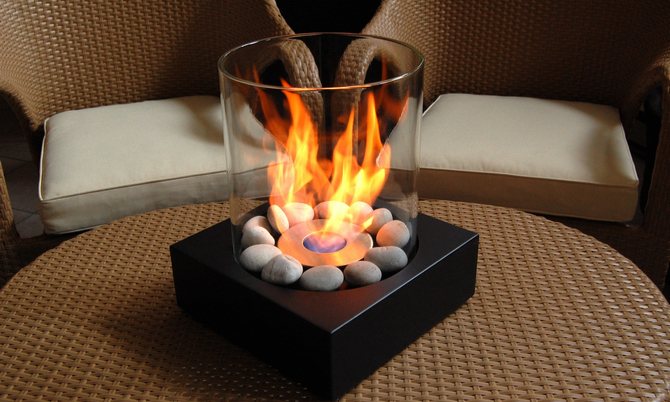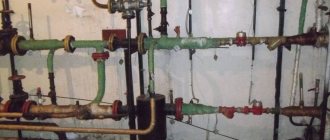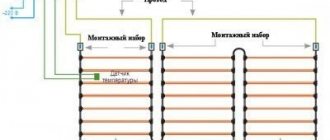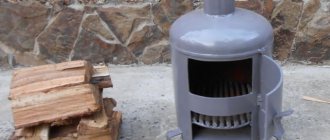A fireplace with a bio prefix works great in city apartments. The device does not require permits, chimney, fuel storage room. The spectacular machine does not process traditional firewood. So what does he need to burn? Agree, you need to understand the issue if you plan to acquire an environmentally friendly fireplace.
We will tell you in detail how to choose the right fuel for your bio fireplace. Here you will find out what kind of fuel is required for its stable and safe operation, what are the advantages of its use. The article presented to your attention will introduce you to popular brands of fuel.
We present to your attention a detailed description of the types of fuel used to make and maintain a fire in bio fireplaces. A recipe for self-preparation of the simplest fuel is presented and scrupulously analyzed. Recommendations are given for refueling and lighting the fireplace, the observance of which will exclude the occurrence of threatening situations.
What is biofuels?
Bioethanol is an environmentally friendly vegetable product that is produced on the basis of renewable agricultural products and is a completely renewable energy source. The combustion of biofuel does not emit smoke, odor or any harmful substances - it is completely safe for humans and the environment. Complete combustion takes place, no ash, soot and soot remain. Only water vapor and CO2 are released, as when breathing in humans.

Biofuel for fireplaces
Fuel for biofireplaces in its energy characteristics is not inferior to less environmentally friendly materials such as biogas and biodiesel. The first is a product similar to natural gas. It is obtained after processing various garbage wastes, and is not extracted naturally from the depths of the earth. It is often used to create thermal and mechanical energy. Biodiesel is made from vegetable oil and is used for refueling cars and other industrial purposes.
Bioethanol is mainly used for refueling biofireplaces. It is characterized by colorlessness and flammability. In the process of making combustible material, denatured ethanol is involved, which is obtained on the basis of ordinary alcohol.
As a percentage, the composition of the fuel for biofireplaces is as follows:
- ethyl alcohol - 95%;
- water - 4%;
- solvent methyleticleton - 0.5%;
- odor and color additives - 0.5%;
- denaturing bitrex - 0.01%.


What fuel looks like for a biofireplace
In its pure form, ethanol does not emit an odor after combustion, but some manufacturers add fragrances to fireplace fluids. During the combustion process, the room may smell like rosemary, coffee, pine needles, birch wood, etc. However, when using flavored fuel, care must be taken to ensure good ventilation.
Some manufacturers offer bioethanol in combination with sea salt. At the moment of burning, it emits a slight crackle, similar to the sounds from real logs. The orange color of the flames is obtained due to special additives added to the fuel.
When bioethanol burns, beautiful and even flames are formed, which look like a living fire. The efficiency of such caines is at least 95%. This is enough to completely heat a small room. Thus, the biofireplace will perform not only a decorative role, but also a heating one.
Is it difficult to install a biofireplace?
The biofireplace assembly is simple and does not require any special skills. Since the biofireplace does not need a chimney, the installation does not require much effort and time. If you bought a freestanding model, you can freely move it around the room - choose the place you like, put the bio fireplace there, and you can already use it. If you have a wall model, installing it is comparable to hanging a mirror or shelf. The kit always includes the necessary fasteners, you do not have to buy anything yourself.
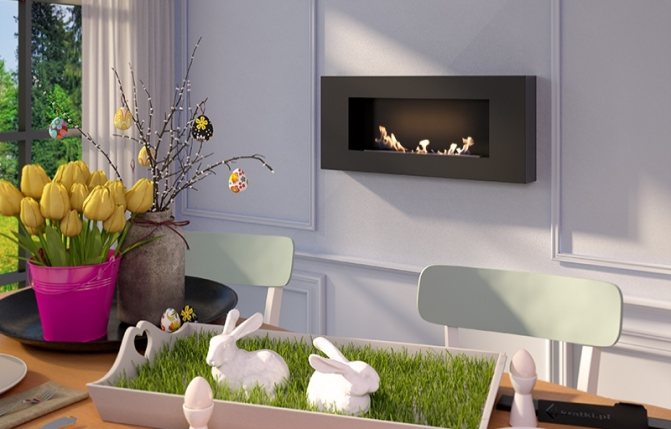

Installation features
In fact, there is nothing difficult in installing such devices, because they can be installed in any apartment, house, there are even biofireplaces for summer cottages. What should we pay attention to:


The original chest of drawers in the form of a fireplace
- First of all, it is necessary to choose a worthy place for the bio fireplace, since this device will become the defining one in the interior of the room, all attention will be drawn to it. It is advisable to allocate a whole wall for the biofireplace, remove other decorative elements from it (paintings, photographs, carpets), remove the TV. An advantageous corner placement may be considered. It is worth remembering that there should be no easily flammable objects near the eco-fireplace, for example, curtains or textiles, synthetic materials, carpets, paper wallpaper.
- For normal operation of the biofireplace, good ventilation should be made in the room. The fact is that during its operation, the eco-fireplace dries the air greatly, taking oxygen from it for combustion processes. Ventilation will compensate for oxygen deficiencies, besides fresh air will add moisture. The circulation of air masses will rid you of carbon dioxide, which is still emitted in small quantities. Is a biofireplace dangerous without a chimney and hood, of course not, but it is necessary to create good conditions for its operation.
- You should choose a device for your room size. If you have a large space, then there are no special restrictions, but for small rooms you should take the appropriate devices. For example, corner options are perfect for small spaces, which save space to a large extent. An interesting option can be a wall-mounted biofireplace, which, when suspended, will look like a natural TV, which can also be enjoyed for a long time. For very small rooms, you can choose the desktop version of the eco-fireplace, or build the system directly into the furniture. There are original coffee tables with built-in sources of real fire. Turn on your imagination at full power, study articles about bio fireplaces, consider all proposals and choose a worthy option for yourself.


The simplest biofireplace design
- It should be noted that the installation of a bio-fireplace does not require connection to utility networks, no need to pull wires, bring pipes and hoods. Many ordinary people are interested in whether an outlet is needed for a bio fireplace - this happens in rare cases when the system is equipped with many additional functions, but in most cases it is not needed. All that is required during installation is to assemble the device, fill it with fuel and start it up. In the future, it is only necessary to maintain its appearance in a normal state and fill with fuel before launching.
Good to know: Corner biofireplace, its advantages and use in the interior
In most cases, it is not even necessary to assemble the biofireplace, since it is assembled in the package. If you bought a floor-standing version, then you do not need to move it close to the wall, it is advisable to leave a gap of several centimeters.


Small bio fireplace on a special table
In the suspended version, everything has already been thought out, it remains only to determine the height. Designers recommend hanging the device at a distance of 30-40 centimeters from the floor.It is more convenient to carry out work together, so as not to make mistakes and hang the device on a level.
During operation, remove dust from the device, wipe the glass of its screen. In hardware stores, special fluids are sold for carrying out such work. The device is cleaned and washed in a cooled state.
As you can see, modern biofireplaces with real fire are completely unpretentious devices that can be placed in almost any room. Consider the advantages of biofireplaces and their disadvantages, which, like any other device, are certainly present.
How to clean the bio fireplace fuel block?
Since the bio-fireplace burning bioethanol does not emit any substances other than carbon dioxide and water vapor, there is no need to clean anything after using it. If you want to update the burner over time, you can use any stainless steel cleaner, just make sure it's cool after use.
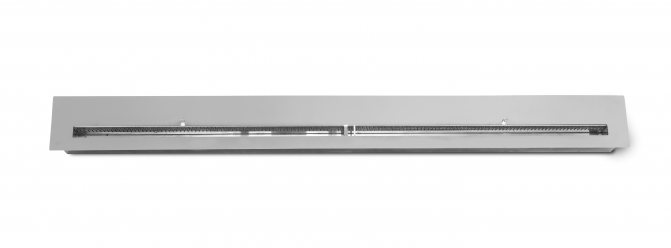

General overview of the device
A fireplace in the house is a desired dream of many people, but city dwellers hitherto could only dream of it. Everything changed when an ecological fireplace was created, which practically does not emit anything when burning, nevertheless, the fire in it is real. It is very strange, you might think, but in fact, eco fireplaces are quite simple devices, differing exclusively in size, shape and materials from which they are made.
The easiest way to understand the principle of operation of a biofireplace is by considering its constituent parts, which in each such device perform certain tasks. Typically, a biological fireplace consists of a burner, a fuel tank, a base, and a portal or fire screen. Biofireplace works thanks to special fuel.
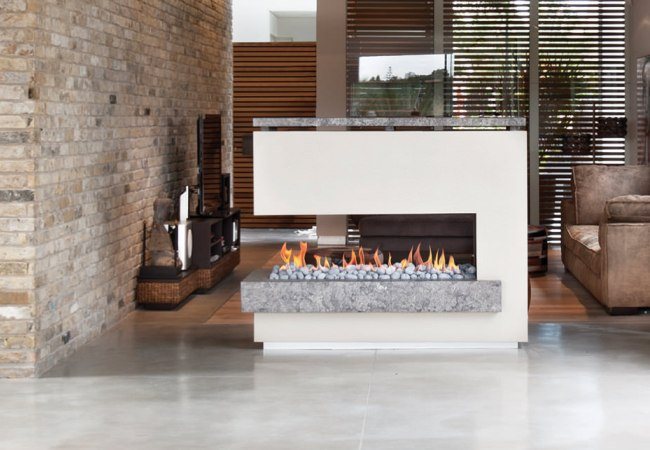

Interior featuring a biofireplace
- The main element of an eco-fireplace is a burner, which is usually made of non-combustible materials: stone, metal, ceramics. To hide this element of the device, the burner is often lined with decorative elements similar to wood or coals, real stones, sand. All decorative parts are made of non-combustible materials. If you wish, you yourself can report suitable items to the portal. The burner burns biofuel.
- Vegetable alcohol and bioethanol are used as biofuels. Eco-friendly ethanol for the bio fireplace is made from plant crops rich in sugar. I usually use beets, reeds, or plain wood. Thus, only natural components get into the composition of biofuels for biofireplaces, no chemicals are added. When burning, vegetable alcohol does not emit elements characteristic of firewood and coals: sparks, soot, soot, smoke. The combustion of fuel produces only a small fraction of carbon dioxide and water vapor. According to the level of emissions into the atmosphere of the room, experts compare the work of a biofireplace with a lit candle. That is why an exhaust hood and a chimney are not needed for the device, because it will not greatly spoil the air in the room. The consumption of biofuel for the operation of the biofireplace is small, and a special fuel tank is built into the system for its storage.
- The fuel tank can be open or closed, i.e. you can personally see the amount of liquid next to which the burner is burning, or bioethanol will be inside the device. In any case, it is necessary to refuel the device in the switched off and cooled state. The size of the fuel tank allows the device to work for several hours, radiating its bio-heat, and giving the opportunity to admire a real fire.
- The portal in which the fire is burning is usually made of tempered glass. Its main task is to ensure safety and unhindered access to fire. You will be able to observe live fire from anywhere in the room, while the surrounding objects will be protected from its pernicious effects. In many ways, the portal determines the appearance of the entire device, its dimensions.The power of the biofireplace can be different, but with any adjustment, the flame will not go beyond the protective screen.
- The final element of the biofireplace can be considered a frame on which all its elements are attached, as well as decorative structures. The frame provides the stability of the device on a flat surface, or firmly mount the system to the wall. Decorative structures are attached to the fireplace frame, which give the device a certain look. All these elements are made of refractory materials.
- Bio fireplace or electric fireplace can be equipped with additional functionality. For example, many systems provide sound design that allows you to even more believe in the presence of living fire. Many eco-fireplaces are equipped with various control sensors that monitor the performance of the device. Finally, remote controls allow you to start biofireplaces without assistance, it is even possible to turn on systems from phones, tablets.


Contrasting interior in a large room of a private house
What is a bio fireplace, nothing more than an improved fireplace on ordinary wood, adapted for use in urban environments.
Good to know: How the burner for a biofireplace is arranged, drawings, do-it-yourself manufacturing
Today, the following main types of biofireplaces can be distinguished:
- Floor standing, installed on all flat surfaces and having large dimensions.
- Suspended, with special mounts for hanging the system on the wall.
- Recessed, installed in niches of walls or furniture.
- Desktop, small devices that allow you to have live fire on the table.
- Corner corners, specially designed for corner installation, can be either floor-standing or suspended.
How the biofireplace works is now clear, so let's consider the possibilities of installing it in an apartment or house.
Wall mounted bio fireplaces
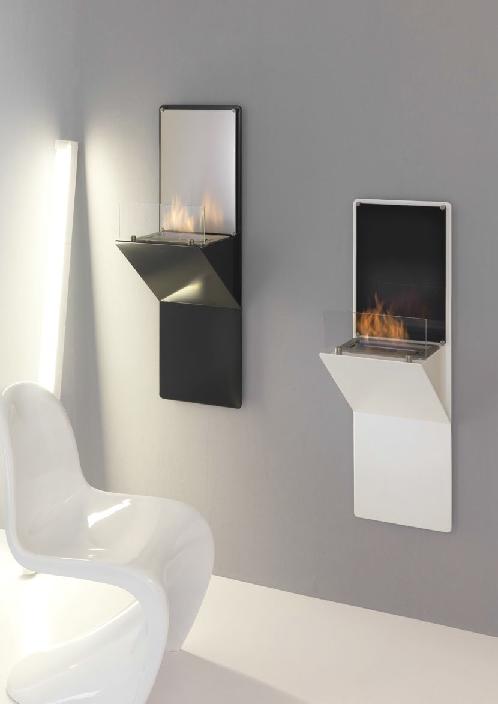

A fireplace hanging on the wall can rightfully be called the most unusual design solution. Unlike other models, it has several installation requirements.
- Wall mounting must be carried out strictly level.
- A wall-mounted fireplace requires free space on top. It should not be placed near bookshelves or curtains.
Important! It should be noted that these two rules are also relevant for other types of biofireplaces. Despite all the safety of the structure, it should not be placed in contact with flammable objects.
Bio fireplace insert: principle of operation
Different installations have a fuel tank or an open tank with a biofireplace burner with a volume of 2 to 9 liters.
IMPORTANT: Multiple burners can be used to provide a continuous line from the flame.
We recommend that you also study on this topic:
Fuel for biofireplaces: description, characteristics, manufacturing
Bio fireplaces are a modern piece of interior design for many apartments and cottages. Fans of a living hearth in the house no longer have to install a familiar brick fireplace in their home, build in a chimney and coordinate its location with the fire inspectorate.
15397 1 0
Regardless of how the biofireplace is arranged, the principle of action is as follows:
- Special fuel is poured into the heating compartment.
- A movable cover fitted to the rails helps regulate the intensity of the flame.
- The fireproof cladding protects the surrounding objects from the risk of fire.
- Stainless steel keeps the case from deforming during heating.
- Quality models have an offset system for refueling, which makes this process safe.
- The technology of manufacturing biofireplaces takes into account the design features that ensure the free exit of gases from the interior of the installation.
We recommend that you read the material on creating a desktop biofireplace in addition to this article.
How to choose a biofireplace?
Appearance is not the only thing that pays attention to when examining the assortment in a store. The set of technical characteristics will help you choose the model that will be ideal for a particular room. When buying, you need to get acquainted with several important parameters. The list of properties includes:


- Biofireplace power. It is synonymous with the height of the flame, its saturation, the heat transfer of the device. This figure for the most powerful devices can reach 7 kW. This value will make it possible to heat a room with an area of about 70 m2. However, it should be borne in mind that in the summer it will not be very comfortable to be in a room with such a bio fireplace: the heat will be very strong.
- Fuel tank volume. The larger the container, the longer the fire will burn after refueling the device. The maximum volume of the tank is 9 liters, but even with its smaller capacity, the main condition for filling a new portion is its emptying. We must let the fuel burn out to the end.
- Burner: material and thickness. There are two options available - ceramic or stainless steel. The thickness of the last burner must be at least 3 mm, more is better. There are double-circuit designs that return excess fuel to the fuel block.
- Fuel consumption. It only depends on the mode of operation chosen by the owners. If we take the average figures as an example, then we should focus on 300-700 ml per hour.
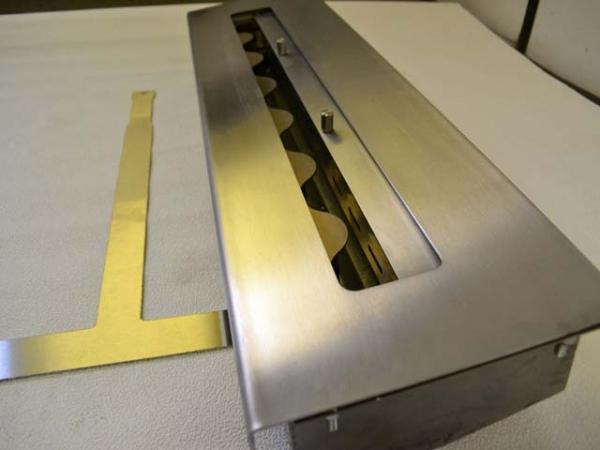

All these characteristics cannot be considered separately, without taking into account the future room chosen for the installation of the hearth. For example, if the goal of the owners is heating, then buying such a fireplace is irrational, since the price of biofuel is quite high. Due to the growing concentration of carbon dioxide, the room will often have to be ventilated, therefore such a "duet" - a small space plus a powerful device - will require frequent opening of windows or vents.
The internal structure of the biofireplace
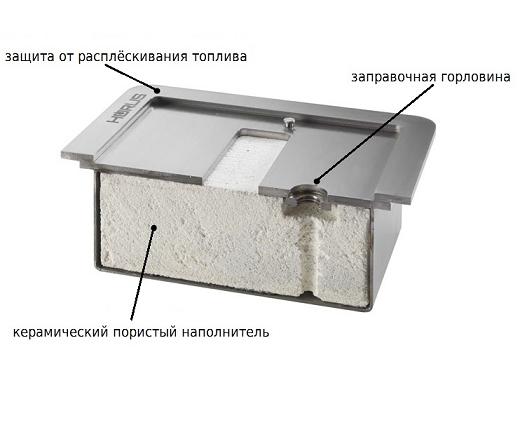

The fuel supply system in biofireplaces is far from original, it has been used for a very long time in the production of gasoline lighters. The secret is in the ceramic filler, which is impregnated with alcohol. The main advantage of this design is that as a result of an accidental fall, the fuel will not spill out.
Important! When refueling the biofireplace, it is necessary to completely extinguish the fire and wait about 15 minutes until it cools completely.
The intensity of combustion of the flame can be adjusted using a slider knob that closes or opens the burner hole. In order to extinguish the fireplace, simply turn the knob and shut off the access of oxygen to the inside of the tank.
Ignition instructions also fit in one sentence, by turning the knob, the shutter is opened and a burning match is brought up. In order not to burn yourself, it is better to use special fireplace matches or a remote lighter.
Interesting! The combustion temperature of alcohol is much lower than that of gasoline or solid fuel, so it is much more difficult to burn yourself with an alcohol flame. But you shouldn't forget about elementary safety either. Open fire, even with alcohol, can be dangerous if neglected.
Installation in a house or apartment
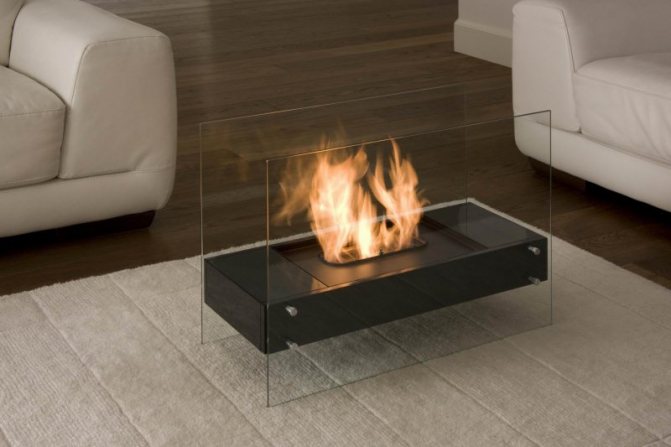

There is no need to assemble the biofireplace, because all models are supplied assembled.
It is only necessary to install correctly, depending on the selected type:
- Floor models installed from the wall with a gap of a couple of centimeters.
- To install a wall-mounted model first you need to decide on the height at which it will be. Often, the minimum distance from the floor is 40 cm, and the maximum is 140 cm. Two people need to hang the wall model.
Regardless of the model, the evenness of the installation is checked by a hydro level.
During the operation of the biofireplace, it is recommended to keep the doors ajar, or install windows for micro-ventilation. Such measures are necessary for the additional flow of oxygen and to avoid the accumulation of carbon dioxide.
As for care, it is enough to wipe the biofireplace with a soft cloth. Glass surfaces are cleaned with glass cleaners. The heating block is cleaned with hot water.
Attention! The biofireplace should be taken care of when the heating unit is off. Fuel should only be added to the unit when it is off.
Refueling instructions:
- Put out the flames and wait until it cools completely.
- Top up the required amount of fuel.
- Light the flame.
The use of biofireplaces - paper products for ignition is excluded. A long metal lighter supplied with the biofireplace is used for lighting.
Biofireplace fuel


Purified natural alcohol, ethanol, is used as fuel for the biofireplace. If you strain your memory well, you can remember how alcohol lamps were used in chemistry lessons in school for various experiments. In fact, a biofireplace is an alcohol lamp brought to perfection.
The uniqueness of this fuel is that it does not produce harmful gases as a result of combustion, which means that it can be used in small closed rooms without the use of special hoods. And since there is no hood, then the efficiency is much higher, according to experts, it can reach 95%, which makes the biofireplace not only an interior item, but also a kind of heating device.
How does a biofireplace work?
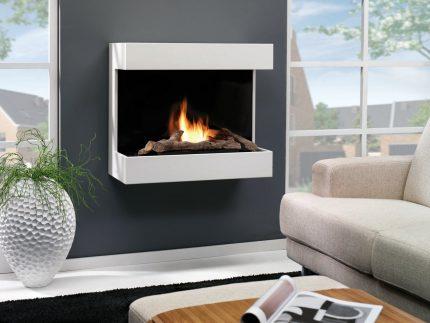

Safety and elementary implementation are the advantages of this type over traditional wood-burning hearths. These advantages are explained by the features of the device and the characteristics of biofuel. It is quite easy to understand the principle of operation of the structure, since the fireplace is very simple to work:
- a suitable fuel is poured into the fuel tank through a funnel;
- it is absorbed into the filler, which has a porous structure, or is distributed between the chips;
- then the biofuel vapors rise to the nozzle, and after firing up they begin to burn evenly, giving out a flame.
All models have the ability to adjust the intensity of the fire. In inexpensive devices, this is done manually. In the most expensive bio fireplaces, the process is controlled by an electronic system that has a large number of modes.
Built-in bio fireplaces
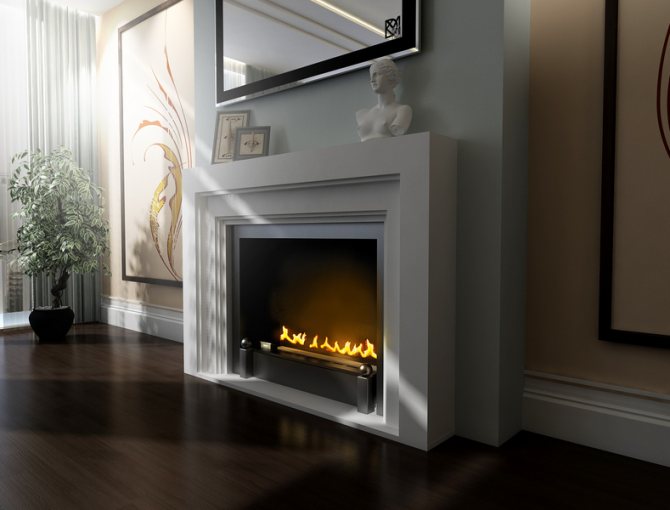

The most difficult version of the biofireplace to install. Installed in a niche specially prepared for it, which can be located both in the floor area and at a certain height.
It is necessary to plan the installation of such a fireplace even at the stage of construction or renovation of the premises. The niche does not require any design features, but its dimensions must clearly correspond to the data of the fireplace. This concerns the height of the burning flame and the peculiarities of refueling the selected model.
What is a bio fireplace?
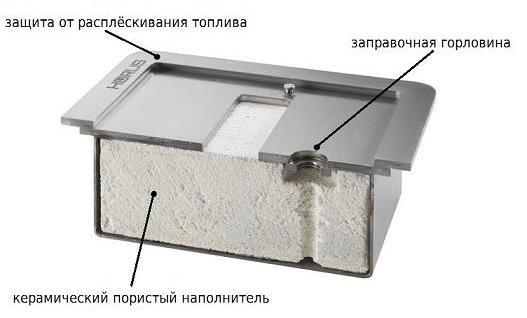

Its other names are alcohol fireplace, alcohol fireplace, or bioethanol. This device is a modern type of environmentally friendly device, which is an analogue of a traditional fireplace and becomes an excellent alternative to those deceptive designs that only imitate a live fire. This equipment is a chance to get an original decorative element that is environmentally friendly, does not require firewood, without acrid smoke, but with a flame that is not so fond of humanity to watch.
The first biofireplace appeared in 1977, it was invented by the Italian engineer Giuseppe Lucifora, who was the first to suggest using ordinary industrial alcohol instead of the usual firewood. Due to the absence of a chimney and all the dangers associated with it, the novelty alcohol centers began to quickly gain popularity. How does a biofireplace work? The basis is a simple principle of combustion, but not solid fuel, but alcohol, or rather, its vapors.
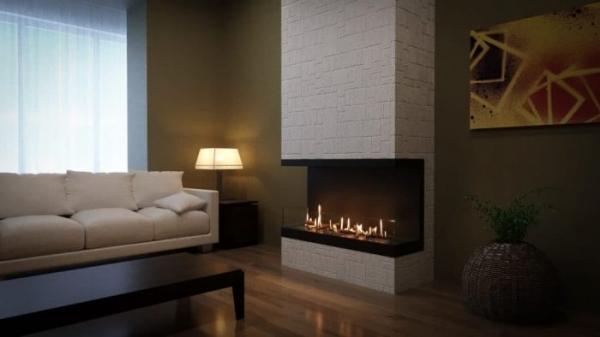

Bioethanol is incapable of burning in the absence of oxygen, so the flame appears only on its surface. Vapors of a substance, mixing with air, ignite. If you close the access to oxygen, the flame will go out.During the combustion of ethanol, water vapor and carbon dioxide are released, so there is no unpleasant smell, soot and smoke at all. For this reason, there are no "contraindications" for the use of such devices in apartments, houses or offices.
The biofireplace can be placed both indoors and outdoors: for example, in an open gazebo, on a terrace, or in a recreation area - for a while. Installation of environmentally friendly, safe equipment does not require any permits or preparation of a site for a bio fireplace.
Biofireplace in the interior
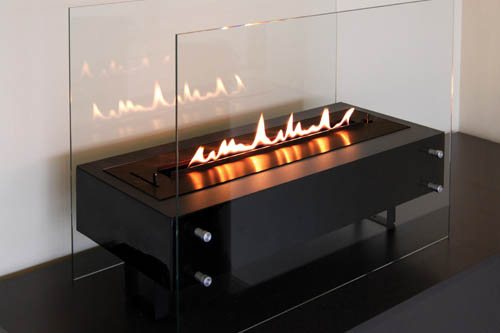

Analyzing the question - biofireplaces, what are they, one cannot but touch on their external data... After all, this is precisely the uniqueness of these devices.
By the way, some companies today offer to make a biofireplace according to an individual project and a customer's sketch. The cost of such a piece of furniture, of course, will be much more expensive, but it cannot be otherwise with truly exclusive things.
But let's talk about typical fireplaces and their varieties.
Advantages and disadvantages
The first thing you need to know about biofuels is that it does not emit smoke, harmful gases, and does not leave behind soot and soot. In addition, natural fuel has the following advantages:
- the intensity of fuel combustion in the fireplace can be adjusted;
- to use it, you do not need to build a chimney, install an exhaust hood and use special installations;
- burners after combustion of bioethanol are easy to clean;
- fireplaces running on biofuel are absolutely safe, because have thermal insulation of the body;
- bioethanol is easily transported, and fireplaces with such fuel are simply assembled, dismantled and moved from place to place;
- one hundred percent heat transfer (no heat loss in the chimney);
- no ash remains from biofuel, no need to harvest firewood and remove garbage from them near the fireplace;
- during the combustion of bioethanol, the air is humidified due to water vapor released into the atmosphere.
There are no particular drawbacks to the fuel itself. The only thing that can cause difficulties is improper operation of the fireplace. In addition, ethanol is a flammable liquid, so certain safety rules must be followed during its use.

